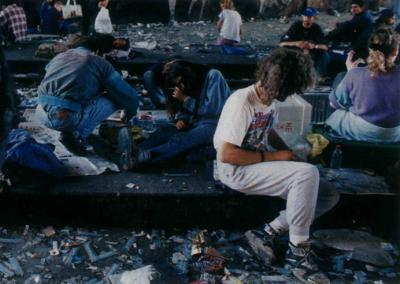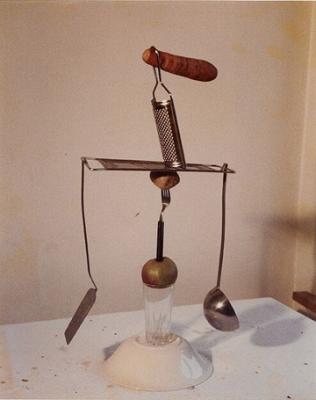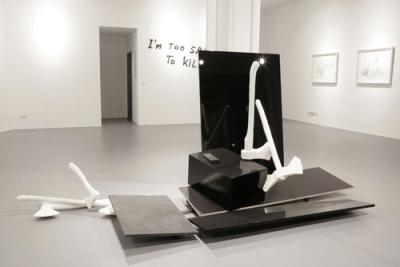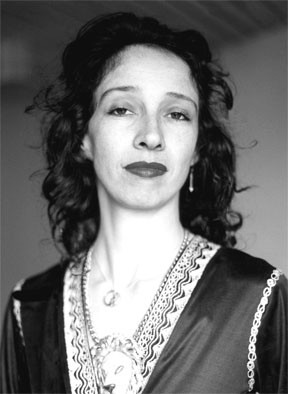An Introduction to Switzerland's Artistic Epicenter
When hungry for subculture and the arts, I always use the same tactics. I’ll find the city’s center, or the main train station, and start walking. Then I try to find a worthy take-away. You never find authentic food in those places indicated in guide books. You find it in those little places run by immigrants, regardless of whether it’s in Camden Town, London, Rue de Charbon, Paris, Berlin’s Neukölln, or Zürich’s Kreis 4 and 5, known as the Langstrasse Area, Switzerland’s most lively and colourful place to be for artists.

As soon as there are posters and graffiti on the walls, Turks selling fruit, and junkies asking for spare change, I know I’m in the right place. The stores are less glossy here, flats are cheaper, and soon I’ll find something nice to eat. And then – and I bet it doesn’t take more than five minutes – I’ll begin to see them walking around, the young couples, dressed in their typical melange of flee-market (excuse me) individuality and pret-a-porter accessories. To be sure, they are probably future lawyers or musicians, but they live just around the corner, go out often at night, and share a common interest: the arts and the life of its subculture. And this is what this Issue of Nomadpaper is all about, in Zürich today.

And in Zürich, I recommend that you start out by eating at a friendly Lebanese fast-food place called Délices d’Orient, 10 minutes by foot from the main station, and close to the southern end of Langstrasse. Langstrasse means Long Street, and for this small city of 370,000, it is indeed a very long street, approximately 2 kilometers. But what is important is that it connects Kreis 4 and 5, Zürich’s most lively and creative areas.
At one time, only workers and a small community of Jews lived in this area. It was called Aussersihl. When it declared bankruptcy in 1893, it was integrated into the larger city of Zürich. But ninety relatively tranquil years later, Zürich experienced a series of violent youth revolts which aimed at establishing culture centers for the young, as well as creating a new and autonomous Aussersihl. And it was in the wake of this unrest that not only an influential punk subculture developed, but also a drug scene which became known world-wide. Throughout the late eighties and early nineties, addicts from all over Europe came to so-called “Needle Park,” located right in front of the main train station, and just three minutes from the northern end of Langstrasse. Imagine a gathering of hundreds of junkies in the midst of this business capital. Inner city kids grew up playing “cops” and “junkies.” It’s Switzerland, remember.
In the mid-nineties the local administration closed down the park. What this meant was that junkies flooded the Langstrasse. One result of this was that the rents sank to an incredibly low level, in comparison to the rest of this expensive city (compare the situation to Paris), and those who couldn’t afford more, and were willing to deal with the noisy, smelly streets and the red light environment, were able to find a place with a lot of formerly, very uncommon liberties. And given that the police were too busy to be bothered with petty crime or trying to close down the booming scene of illegal clubs, the areas of Kreis 4 and 5 – the Aussersihl -- finally became once again, in some sense, autonomous. And a massive inflow of young people began.
But other things were happening. In Kreis 4, in 1986, the first alternative art space, Kunsthaus Oerlikon, had started what was often an alcohol-financed mixture of local arts activism and a “good time,” and as it turned out, throughout the nineties this “in-between” party-gallery mix, mostly in places selected at the last-minute, began to spread throughout the Langstrasse area. In spite of the fact that those participating were mostly local, what was important was that people were connecting, developing visions, and proposing wild, creative, weird and often funny projects. One of the many young galleries emerging at the time is said to be founded on money coming from a marijuana plantation. But from all this emerged a Zurich arts scene which has grown rapidly and is now internationally recognized. The period from 1999 to 2003 was called “Das Zürcher Kunstwunder” -- the Zurich Arts-Wonder. And while Swiss feuilletonists predicted it wouldn’t get bigger, it did. And finally it has become visible to everyone. In the Langstrasse.

But let’s go back to our Lebanese fast-food place, Délices d’Orient. After we have gotten our take-out, we will start out from near a squatters’ building called the Kalkbreite, which is at the south pole of Kreis 4. After the youth revolts, political squatter activism merged with creative action into a sort of pragmatic punk-anarchism, and this movement has strongly influenced the Zürich art scene. A few meters away here, the Langstrasse begins, and as we walk along we will soon cross the infamous Kanzlei-areal. Saturdays, it’s a colourful flee market, but also turns into a meeting point for the entire art scene of the young. It is quite possible that Cristian Andersen – one of the other artists featured in this issue -- will pass by and say “Hi!,” while over there is Jean-Claude Freymond Guth, founder of Les Complices (just 1 minute from the Flee market), and now working with the Perla Mode. And nearby are some of the city’s best record stores and bars. Two blocks up, we will see Zürich’s most important Off-Space Perla Mode , shared by Nieves Books (who publishes magnificent little art-books!), and Esther Eppstein (Zürich’s Madame Off-Space), and Freymond Guth and the Wartesaal collective. And then there is Giovanni Carmine (PAGE XX), curator of Kunsthalle Sankt Gallen, who could call Perla his living room. Just across the street, we can see the newly integrated Café-Club-Store, Das Haus. And at the next intersection, on the left, just look up and you will see the Schönegg Haus, home of the arts and grafics magazine soDA, a magazine that is sold at places like the Tate Modern.

A bit further north, after going over the tracks of the main train station nearby, we arrive at Kreis 5. Here we have institutions rather than “squats”: The Museum for Gestaltung (offering collections of Design, Grafics, Posters and Arts), the Zurich University of Arts, and the brick-red Löwenbräu Areal, a former factory perched 200 meters from the top of Langstrasse, and transformed in 1996 into a huge center for contemporary arts, housing Kunsthalle, Migros Museum, and several international gallerys like Kilchmann, Luxembourg de Pury and Hauser & Wirth.
If you are still hungry for the arts and its subculture after making your way along these two kilometres, you have a problem! But just in case you aren’t hungry, there are some perfect restaurants in Kreis 5. And while you are dining, you can reflect upon this incredibly condensed, very productive and internationally successful artist community – or start reading No Mad Magazine to nibble on more details.
check: http://www.nomadpaper.com/zuri-ba_img.html

As soon as there are posters and graffiti on the walls, Turks selling fruit, and junkies asking for spare change, I know I’m in the right place. The stores are less glossy here, flats are cheaper, and soon I’ll find something nice to eat. And then – and I bet it doesn’t take more than five minutes – I’ll begin to see them walking around, the young couples, dressed in their typical melange of flee-market (excuse me) individuality and pret-a-porter accessories. To be sure, they are probably future lawyers or musicians, but they live just around the corner, go out often at night, and share a common interest: the arts and the life of its subculture. And this is what this Issue of Nomadpaper is all about, in Zürich today.

And in Zürich, I recommend that you start out by eating at a friendly Lebanese fast-food place called Délices d’Orient, 10 minutes by foot from the main station, and close to the southern end of Langstrasse. Langstrasse means Long Street, and for this small city of 370,000, it is indeed a very long street, approximately 2 kilometers. But what is important is that it connects Kreis 4 and 5, Zürich’s most lively and creative areas.
At one time, only workers and a small community of Jews lived in this area. It was called Aussersihl. When it declared bankruptcy in 1893, it was integrated into the larger city of Zürich. But ninety relatively tranquil years later, Zürich experienced a series of violent youth revolts which aimed at establishing culture centers for the young, as well as creating a new and autonomous Aussersihl. And it was in the wake of this unrest that not only an influential punk subculture developed, but also a drug scene which became known world-wide. Throughout the late eighties and early nineties, addicts from all over Europe came to so-called “Needle Park,” located right in front of the main train station, and just three minutes from the northern end of Langstrasse. Imagine a gathering of hundreds of junkies in the midst of this business capital. Inner city kids grew up playing “cops” and “junkies.” It’s Switzerland, remember.
In the mid-nineties the local administration closed down the park. What this meant was that junkies flooded the Langstrasse. One result of this was that the rents sank to an incredibly low level, in comparison to the rest of this expensive city (compare the situation to Paris), and those who couldn’t afford more, and were willing to deal with the noisy, smelly streets and the red light environment, were able to find a place with a lot of formerly, very uncommon liberties. And given that the police were too busy to be bothered with petty crime or trying to close down the booming scene of illegal clubs, the areas of Kreis 4 and 5 – the Aussersihl -- finally became once again, in some sense, autonomous. And a massive inflow of young people began.
But other things were happening. In Kreis 4, in 1986, the first alternative art space, Kunsthaus Oerlikon, had started what was often an alcohol-financed mixture of local arts activism and a “good time,” and as it turned out, throughout the nineties this “in-between” party-gallery mix, mostly in places selected at the last-minute, began to spread throughout the Langstrasse area. In spite of the fact that those participating were mostly local, what was important was that people were connecting, developing visions, and proposing wild, creative, weird and often funny projects. One of the many young galleries emerging at the time is said to be founded on money coming from a marijuana plantation. But from all this emerged a Zurich arts scene which has grown rapidly and is now internationally recognized. The period from 1999 to 2003 was called “Das Zürcher Kunstwunder” -- the Zurich Arts-Wonder. And while Swiss feuilletonists predicted it wouldn’t get bigger, it did. And finally it has become visible to everyone. In the Langstrasse.

But let’s go back to our Lebanese fast-food place, Délices d’Orient. After we have gotten our take-out, we will start out from near a squatters’ building called the Kalkbreite, which is at the south pole of Kreis 4. After the youth revolts, political squatter activism merged with creative action into a sort of pragmatic punk-anarchism, and this movement has strongly influenced the Zürich art scene. A few meters away here, the Langstrasse begins, and as we walk along we will soon cross the infamous Kanzlei-areal. Saturdays, it’s a colourful flee market, but also turns into a meeting point for the entire art scene of the young. It is quite possible that Cristian Andersen – one of the other artists featured in this issue -- will pass by and say “Hi!,” while over there is Jean-Claude Freymond Guth, founder of Les Complices (just 1 minute from the Flee market), and now working with the Perla Mode. And nearby are some of the city’s best record stores and bars. Two blocks up, we will see Zürich’s most important Off-Space Perla Mode , shared by Nieves Books (who publishes magnificent little art-books!), and Esther Eppstein (Zürich’s Madame Off-Space), and Freymond Guth and the Wartesaal collective. And then there is Giovanni Carmine (PAGE XX), curator of Kunsthalle Sankt Gallen, who could call Perla his living room. Just across the street, we can see the newly integrated Café-Club-Store, Das Haus. And at the next intersection, on the left, just look up and you will see the Schönegg Haus, home of the arts and grafics magazine soDA, a magazine that is sold at places like the Tate Modern.

A bit further north, after going over the tracks of the main train station nearby, we arrive at Kreis 5. Here we have institutions rather than “squats”: The Museum for Gestaltung (offering collections of Design, Grafics, Posters and Arts), the Zurich University of Arts, and the brick-red Löwenbräu Areal, a former factory perched 200 meters from the top of Langstrasse, and transformed in 1996 into a huge center for contemporary arts, housing Kunsthalle, Migros Museum, and several international gallerys like Kilchmann, Luxembourg de Pury and Hauser & Wirth.
If you are still hungry for the arts and its subculture after making your way along these two kilometres, you have a problem! But just in case you aren’t hungry, there are some perfect restaurants in Kreis 5. And while you are dining, you can reflect upon this incredibly condensed, very productive and internationally successful artist community – or start reading No Mad Magazine to nibble on more details.
check: http://www.nomadpaper.com/zuri-ba_img.html
hannes1 - 7. Jun, 00:24
Prediksi Togel | Bocoran Angka Jitu | Keluaran Singapore HongkongPrediksi Togel Hari Ini | Keluaran Angka Jitu | Ramalan Togel | Bocoran Togel | Togel SGP Singapore | Togel HK Hongkong | Syair Togel
Rumus Togel Jitu
Buku Mimpi Togel
Tabel Shio Togel
Keluaran Togel Hongkong
Keluaran Togel Singapura
Cerita Dewasa 66 | Foto Seks Bergambar Cewek IGO Ngentot
Kimcil Bugil | Koleksi Foto Hijab Narsis Update
Toket Mengkel | Cewek Cute Abg Montok Meki Tembem
Cewek Bookingan | Foto ABG Pamer Toket
Cerita Panas | ABG Suka Pamer Body Bohai
Cewek Asoy Geboy | Ngintip Amoy Dengan Bikini Hot
Cewek Hits | Tempat Kumpulan Cewek Indonesia
Cabe Cabean | Koleksi Foto Hot Menggemaskan Bugil 2016
ABG ababil | Koleksi Pribadi Cewek Primadona Lagi Horny